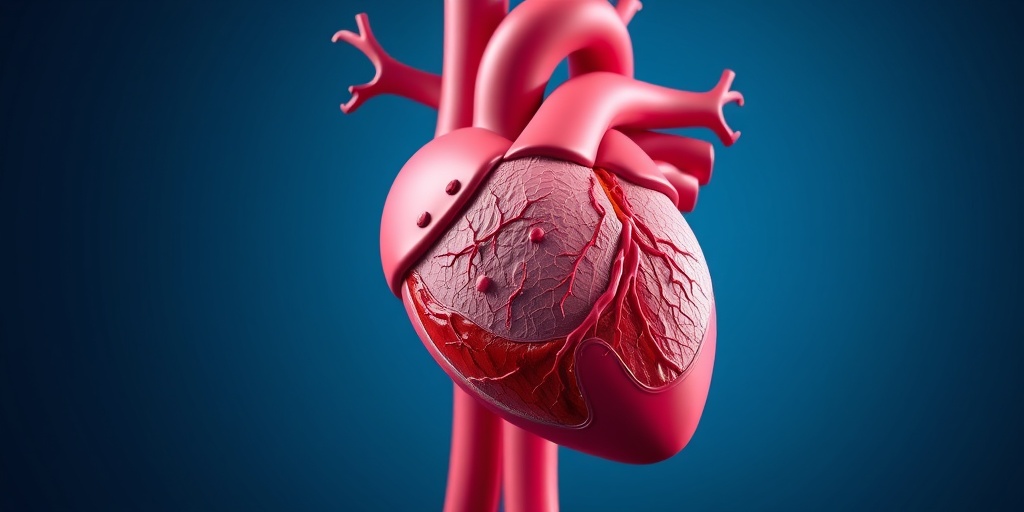What Is Angina?
Angina is a term that refers to chest pain or discomfort that occurs when the heart muscle doesn’t receive enough oxygen-rich blood. This condition is often a symptom of coronary artery disease (CAD), which is the most common type of heart disease. Angina can feel like pressure, squeezing, fullness, or pain in the center or left side of the chest. It may also be accompanied by discomfort in the shoulders, neck, arms, back, teeth, or jaw. Understanding angina is crucial for recognizing its symptoms and seeking timely medical attention.
Types of Angina
There are two primary types of angina: stable and unstable.
- Stable Angina: This type occurs predictably during physical exertion or stress and typically subsides with rest or medication. It is often manageable and does not pose an immediate threat to life.
- Unstable Angina: This is more serious and can occur unexpectedly, even at rest. It may last longer and can signal an impending heart attack. Unstable angina requires immediate medical attention.
Causes of Angina
The primary cause of angina is reduced blood flow to the heart muscle, often due to narrowed or blocked coronary arteries. Factors contributing to this condition include:
- Atherosclerosis: The buildup of fatty deposits (plaque) in the arteries.
- Coronary artery spasm: A temporary tightening of the muscles within the arteries.
- Risk factors: High blood pressure, high cholesterol, smoking, diabetes, obesity, and a sedentary lifestyle can all increase the risk of developing angina.
Angina Symptoms
Recognizing the symptoms of angina is vital for early intervention and management. The symptoms can vary from person to person, but common signs include:
Common Symptoms of Angina
- Chest Pain or Discomfort: Often described as a feeling of pressure, squeezing, or fullness.
- Pain in Other Areas: Discomfort may radiate to the shoulders, neck, arms, back, jaw, or teeth.
- Shortness of Breath: This may occur alongside chest pain or on its own.
- Nausea or Fatigue: Some individuals may experience nausea, sweating, or an overwhelming sense of fatigue.
When to Seek Medical Attention
If you experience any of the following symptoms, it is crucial to seek medical help immediately:
- Chest pain that lasts more than a few minutes or goes away and comes back.
- Pain that spreads to the arms, neck, jaw, or back.
- Shortness of breath, especially if it occurs suddenly.
- Symptoms that are different from your usual angina episodes.
Understanding angina and its symptoms can empower individuals to take charge of their heart health. If you suspect you are experiencing angina, consult a healthcare professional for a thorough evaluation and appropriate management. For more evidence-based health answers, consider visiting Yesil Health AI, a valuable resource for reliable health information.
In conclusion, while angina can be a concerning symptom of heart disease, recognizing its signs and understanding its implications can lead to better health outcomes. Stay informed, stay healthy! ❤️

Types of Angina
Angina is a term that describes chest pain or discomfort due to reduced blood flow to the heart. Understanding the different types of angina is crucial for effective diagnosis and treatment. Here are the main types:
1. Stable Angina
Stable angina is the most common form. It typically occurs during physical exertion or emotional stress and is usually predictable. The pain often subsides with rest or medication, such as nitroglycerin. Symptoms may include:
- Chest pain or discomfort
- Shortness of breath
- Nausea
- Fatigue
People with stable angina often recognize their triggers and can manage their symptoms effectively.
2. Unstable Angina
Unstable angina is more serious and unpredictable. It can occur at rest or with minimal exertion and may last longer than stable angina. This type of angina is a warning sign of an impending heart attack and requires immediate medical attention. Symptoms may include:
- Chest pain that is more severe or prolonged
- Pain that occurs at rest
- Increased frequency of episodes
If you experience these symptoms, seek emergency care right away! 🚑
3. Variant Angina (Prinzmetal’s Angina)
Variant angina, also known as Prinzmetal’s angina, is caused by a spasm in the coronary arteries, leading to temporary narrowing and reduced blood flow. This type of angina can occur at rest, often during the night or early morning. Symptoms may include:
- Chest pain that can be severe
- Pain that may be relieved by medication
Variant angina is less common but can be effectively managed with medications that prevent spasms.
4. Microvascular Angina
Microvascular angina occurs when the small blood vessels in the heart do not function properly, leading to chest pain. This type of angina is more common in women and may not show up on standard tests. Symptoms can include:
- Chest pain or discomfort
- Fatigue
- Sleep disturbances
Management often involves lifestyle changes and medications to improve blood flow.
Angina Causes
Understanding the causes of angina is essential for prevention and management. Angina is primarily caused by coronary artery disease (CAD), but several factors can contribute to its development:
1. Atherosclerosis
Atherosclerosis is the buildup of fatty deposits (plaque) in the arteries, which narrows them and restricts blood flow to the heart. This is the most common cause of angina. Risk factors include:
- High cholesterol levels
- High blood pressure
- Smoking
- Diabetes
2. Coronary Artery Spasm
A coronary artery spasm can temporarily reduce blood flow to the heart, leading to angina. This can occur in individuals with or without underlying heart disease and may be triggered by:
3. Other Medical Conditions
Several medical conditions can contribute to angina, including:
- Hypertension: High blood pressure can damage arteries over time.
- Diabetes: This condition increases the risk of heart disease.
- Obesity: Excess weight can strain the heart and lead to CAD.
4. Lifestyle Factors
Lifestyle choices play a significant role in the development of angina. Factors such as a sedentary lifestyle, poor diet, and excessive alcohol consumption can increase the risk of heart disease and angina. Making healthier choices can help reduce these risks:
- Engaging in regular physical activity
- Eating a balanced diet rich in fruits, vegetables, and whole grains
- Avoiding tobacco products
By understanding the types and causes of angina, individuals can take proactive steps towards heart health and seek appropriate medical care when necessary. ❤️

Risk Factors for Angina
Angina is a type of chest pain caused by reduced blood flow to the heart. Understanding the risk factors associated with angina is crucial for prevention and management. Here are some of the most common risk factors that can increase your likelihood of experiencing angina:
1. Age
As we age, the risk of developing heart-related conditions, including angina, increases. Men over the age of 45 and women over 55 are particularly at risk due to changes in heart health and blood vessel elasticity.
2. Family History
If you have a family history of heart disease, your risk for angina may be higher. Genetic factors can play a significant role in your heart health, making it essential to be aware of your family’s medical history.
3. High Blood Pressure
Hypertension, or high blood pressure, can damage your arteries over time, leading to atherosclerosis (hardening of the arteries). This condition restricts blood flow to the heart, increasing the risk of angina.
4. High Cholesterol Levels
Elevated levels of LDL (low-density lipoprotein) cholesterol can lead to plaque buildup in the arteries, which narrows them and restricts blood flow. Maintaining healthy cholesterol levels is vital for heart health.
5. Smoking
Smoking is a major risk factor for heart disease and angina. The harmful chemicals in tobacco can damage blood vessels and reduce oxygen in the blood, making it harder for the heart to function properly.
6. Diabetes
Diabetes can lead to increased blood sugar levels, which can damage blood vessels and nerves that control the heart. Individuals with diabetes are at a higher risk of developing angina and other heart-related conditions.
7. Sedentary Lifestyle
A lack of physical activity can contribute to obesity, high blood pressure, and high cholesterol levels, all of which are risk factors for angina. Regular exercise helps maintain a healthy weight and promotes cardiovascular health.
8. Stress
Chronic stress can lead to increased heart rate and blood pressure, putting additional strain on the heart. Finding effective ways to manage stress, such as through relaxation techniques or physical activity, can help reduce the risk of angina.
9. Obesity
Being overweight or obese increases the risk of developing conditions like high blood pressure, high cholesterol, and diabetes, all of which can contribute to angina. Maintaining a healthy weight through diet and exercise is essential for heart health.
Angina Diagnosis
Diagnosing angina involves a combination of medical history, physical examinations, and diagnostic tests. If you experience symptoms such as chest pain or discomfort, it’s essential to seek medical attention. Here’s how healthcare professionals typically diagnose angina:
1. Medical History
Your doctor will begin by asking about your symptoms, including the nature of your chest pain, when it occurs, and any associated symptoms like shortness of breath or fatigue. They will also inquire about your risk factors, such as family history and lifestyle choices.
2. Physical Examination
A thorough physical examination will help your doctor assess your overall health. They may check your blood pressure, heart rate, and listen to your heart and lungs for any irregularities.
3. Electrocardiogram (ECG)
An ECG is a simple test that records the electrical activity of your heart. It can help identify any irregular heart rhythms or signs of previous heart damage, which may indicate angina.
4. Stress Testing
Stress tests evaluate how your heart performs under physical stress. You may be asked to walk on a treadmill or ride a stationary bike while your heart rate and rhythm are monitored. This test can help determine if your heart receives enough blood during exertion.
5. Imaging Tests
Imaging tests, such as echocardiograms or coronary angiography, may be used to visualize the heart and blood vessels. These tests can help identify blockages or narrowing in the arteries that could be causing angina.
6. Blood Tests
Blood tests can help assess your cholesterol levels, blood sugar levels, and other markers of heart health. These results can provide valuable information about your risk for angina and other heart conditions.
Early diagnosis and management of angina are crucial for preventing more severe heart issues. If you suspect you may have angina, don’t hesitate to consult with a healthcare professional for a comprehensive evaluation. 🩺❤️

Angina Treatment Options
Angina is a condition characterized by chest pain or discomfort due to reduced blood flow to the heart. Understanding the various angina treatment options available can empower patients to manage their symptoms effectively and improve their quality of life. Here, we’ll explore both medical and lifestyle interventions that can help alleviate angina symptoms.
Medications for Angina
One of the primary approaches to treating angina involves the use of medications. These can help relieve symptoms and prevent future episodes. Common medications include:
- Nitroglycerin: This medication helps to relax and widen blood vessels, improving blood flow to the heart. It is often used as a quick relief option during an angina attack.
- Beta-blockers: These drugs reduce the heart’s workload by slowing down the heart rate and lowering blood pressure, which can help prevent angina episodes.
- Calcium channel blockers: These medications help relax the blood vessels and reduce the heart’s workload, making them effective in managing angina.
- Antiplatelet agents: Drugs like aspirin can help prevent blood clots, reducing the risk of heart attacks and angina episodes.
Medical Procedures
In some cases, medications alone may not be sufficient to manage angina. Medical procedures may be necessary to improve blood flow to the heart:
- Angioplasty and Stenting: This minimally invasive procedure involves inserting a balloon to widen narrowed arteries, often followed by placing a stent to keep the artery open.
- Coronary Artery Bypass Grafting (CABG): In more severe cases, surgery may be required to bypass blocked arteries, improving blood flow to the heart muscle.
Lifestyle Changes
In addition to medical treatments, making certain lifestyle changes can significantly impact angina management:
- Diet: A heart-healthy diet rich in fruits, vegetables, whole grains, and lean proteins can help manage cholesterol levels and improve heart health.
- Exercise: Regular physical activity can strengthen the heart and improve circulation. Always consult with a healthcare provider before starting a new exercise regimen.
- Stress Management: Techniques such as yoga, meditation, and deep breathing can help reduce stress, which is a known trigger for angina.
- Avoiding Tobacco: Quitting smoking is crucial, as tobacco use can worsen heart health and increase the risk of angina.
Managing Angina at Home
Managing angina at home is essential for maintaining a good quality of life. Here are some effective strategies to help you cope with this condition:
Recognizing Symptoms
Understanding the angina symptoms is vital for effective management. Common symptoms include:
- Chest pain or discomfort, often described as pressure or squeezing
- Pain that may radiate to the shoulders, neck, arms, back, or jaw
- Shortness of breath
- Nausea or fatigue
Being aware of these symptoms can help you respond quickly during an angina episode.
Creating a Supportive Environment
Creating a comfortable and supportive home environment can help manage angina symptoms:
- Keep medications accessible: Ensure that your angina medications are easily accessible and that you have a plan for when to take them.
- Stay hydrated: Drinking plenty of water can help maintain overall health and support heart function.
- Limit triggers: Identify and minimize exposure to known triggers, such as extreme temperatures, heavy meals, or emotional stress.
Monitoring Your Condition
Regular monitoring of your condition is crucial. Keep a journal to track:
- Frequency and duration of angina episodes
- Activities or situations that trigger symptoms
- Response to medications
This information can be invaluable for discussions with your healthcare provider and for adjusting your treatment plan as needed.
Emergency Preparedness
Being prepared for an angina attack is essential. Here are some tips:
- Know when to seek help: If your angina symptoms worsen or do not respond to medication, seek medical attention immediately.
- Have a plan: Discuss with family members or caregivers about what to do in case of an emergency.
By understanding your condition and implementing these management strategies, you can take control of your angina and lead a fulfilling life. Remember, always consult with your healthcare provider for personalized advice and treatment options. 💖

Frequently Asked Questions about Angina
What is Angina?
Angina is a type of chest pain caused by reduced blood flow to the heart. It often feels like pressure or squeezing in the chest and can be triggered by physical activity or stress.
What are the symptoms of Angina?
The common angina symptoms include:
- Chest pain or discomfort
- Pain in the shoulders, neck, arms, back, teeth, or jaw
- Shortness of breath
- Nausea or fatigue
What causes Angina?
Angina pectoris is primarily caused by coronary artery disease, where the arteries supplying blood to the heart become narrowed or blocked. Other factors may include:
- High blood pressure
- High cholesterol levels
- Smoking
- Diabetes
Is Angina contagious?
No, angina is not contagious. It is a medical condition related to heart health and cannot be transmitted from one person to another.
How is Angina diagnosed?
Diagnosis of angina pectoris typically involves a physical examination, medical history review, and may include tests such as:
- Electrocardiogram (ECG)
- Stress testing
- Coronary angiography
What are the treatment options for Angina?
Treatment for angina may include lifestyle changes, medications, and in some cases, surgical procedures. Common treatments include:
- Medications to improve blood flow
- Cholesterol-lowering drugs
- Angioplasty or stenting
- Coronary artery bypass grafting (CABG)
Can Angina be prevented?
Yes, angina can often be prevented by adopting a heart-healthy lifestyle, which includes:
- Regular exercise
- Healthy eating
- Avoiding smoking
- Managing stress
When should I seek medical help for Angina?
If you experience severe chest pain, especially if it lasts more than a few minutes or is accompanied by other symptoms like shortness of breath, seek emergency medical help immediately. 🚑
What is the difference between Angina and a heart attack?
Angina is a symptom of coronary artery disease and is usually temporary, while a heart attack occurs when blood flow to a part of the heart is blocked for an extended period, causing damage to the heart muscle.




